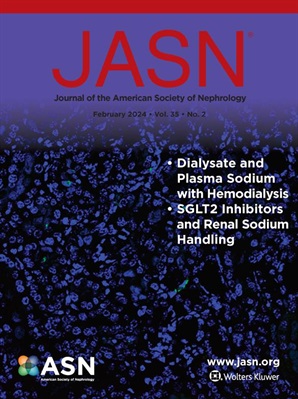Podocyte Metabolic Reprogramming and Targeted Therapy.
IF 9.4
1区 医学
Q1 UROLOGY & NEPHROLOGY
引用次数: 0
Abstract
Podocytes, highly specialized glomerular epithelial cells, are essential for maintaining the filtration barrier integrity, yet they are particularly susceptible to metabolic stress. Recent advances have identified metabolic reprogramming as a central driver of podocyte injury in diverse glomerular diseases, including diabetic kidney disease and focal segmental glomerulosclerosis. Pathological stimuli, such as hyperglycemia, lipotoxicity, oxidative stress, and inflammatory cytokines, lead to profound alterations in podocyte metabolism, encompassing dysregulation of lipid, glucose, amino acid, and ion handling, as well as activation of immunometabolic pathways. These maladaptive changes result in mitochondrial dysfunction, cytoskeletal disorganization, and inflammatory forms of cell death including pyroptosis and ferroptosis. Mechanistic studies have elucidated the roles of nutrient-sensing pathways (AMPK, mTOR, SIRT1), innate immune sensors (NLRP3, cGAS-STING), and metabolic enzymes (CerS6, GLS2, ODC1) in orchestrating this reprogramming. Emerging evidence supports the therapeutic potential of modulating podocyte metabolism, as exemplified by the renoprotective effects of SGLT2 inhibitors, GLP-1 receptor agonists, PPAR agonists, and targeted inhibitors of inflammasome or lipid pathways. This Review synthesizes recent insights into the structural-metabolic coupling in podocytes, dissects the mechanisms of metabolic derangement in disease contexts, and discusses promising therapeutic strategies aimed at restoring metabolic homeostasis. Understanding the intersection between podocyte metabolism and injury response offers novel avenues for the prevention and treatment of chronic glomerular diseases.足细胞代谢重编程和靶向治疗。
足细胞是高度特化的肾小球上皮细胞,对维持滤过屏障的完整性至关重要,但它们特别容易受到代谢应激的影响。最近的进展已经确定代谢重编程是多种肾小球疾病(包括糖尿病肾病和局灶节段性肾小球硬化)足细胞损伤的核心驱动因素。病理性刺激,如高血糖、脂肪毒性、氧化应激和炎性细胞因子,导致足细胞代谢的深刻改变,包括脂质、葡萄糖、氨基酸和离子处理的失调,以及免疫代谢途径的激活。这些不适应的变化导致线粒体功能障碍、细胞骨架紊乱和炎症形式的细胞死亡,包括焦亡和铁亡。机制研究已经阐明了营养传感通路(AMPK, mTOR, SIRT1),先天免疫传感器(NLRP3, cGAS-STING)和代谢酶(CerS6, GLS2, ODC1)在协调这种重编程中的作用。新出现的证据支持调节足细胞代谢的治疗潜力,如SGLT2抑制剂、GLP-1受体激动剂、PPAR激动剂和炎性体或脂质途径的靶向抑制剂的肾保护作用。这篇综述综合了最近对足细胞结构-代谢耦合的见解,剖析了疾病背景下代谢紊乱的机制,并讨论了旨在恢复代谢稳态的有前途的治疗策略。了解足细胞代谢和损伤反应之间的交集为慢性肾小球疾病的预防和治疗提供了新的途径。
本文章由计算机程序翻译,如有差异,请以英文原文为准。
求助全文
约1分钟内获得全文
求助全文
来源期刊
CiteScore
22.40
自引率
2.90%
发文量
492
审稿时长
3-8 weeks
期刊介绍:
The Journal of the American Society of Nephrology (JASN) stands as the preeminent kidney journal globally, offering an exceptional synthesis of cutting-edge basic research, clinical epidemiology, meta-analysis, and relevant editorial content. Representing a comprehensive resource, JASN encompasses clinical research, editorials distilling key findings, perspectives, and timely reviews.
Editorials are skillfully crafted to elucidate the essential insights of the parent article, while JASN actively encourages the submission of Letters to the Editor discussing recently published articles. The reviews featured in JASN are consistently erudite and comprehensive, providing thorough coverage of respective fields. Since its inception in July 1990, JASN has been a monthly publication.
JASN publishes original research reports and editorial content across a spectrum of basic and clinical science relevant to the broad discipline of nephrology. Topics covered include renal cell biology, developmental biology of the kidney, genetics of kidney disease, cell and transport physiology, hemodynamics and vascular regulation, mechanisms of blood pressure regulation, renal immunology, kidney pathology, pathophysiology of kidney diseases, nephrolithiasis, clinical nephrology (including dialysis and transplantation), and hypertension. Furthermore, articles addressing healthcare policy and care delivery issues relevant to nephrology are warmly welcomed.

 求助内容:
求助内容: 应助结果提醒方式:
应助结果提醒方式:


